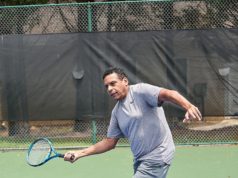By Page Love, MS, RD, CSSD, And Emily Norris, Dietetic Intern
For many of us, springtime means spring cleaning. While you already may have plans to clean out some closets or your garage, have you considered giving your pantry and fridge a sport nutrition makeover? Fueling for tennis requires a special grouping of high-energy foods, but you also may benefit from some new “sport foods” which you could have hidden away in your kitchen. The first step to this cleaning process is to “gut” your cabinets and fridge. As you take items out, sort them into “donate,” “expired” and “keep” piles. Then, it’s time to focus on buying foods that will keep you energized on and off the court. You can use my “Tennis Shopping List” here to determine what staple foods you might be missing.
Grains
Most whole grains have a long shelf life, making them a great item to stock up on during spring cleaning. Whole grains are an important part of any athlete’s diet and they also make the best pre-workout snack and pre-match meal choice. The fiber content keeps you feeling full from one day to the next, and these complex carbohydrates are readily available for your body to use as fuel during play.
A few of my favorites include: whole grain bread/bagels, oatmeal, brown rice, popcorn, potatoes, beans, and energy bars (high-carb – PowerBar, CLIF BAR, Pro Bar, Gatorade Fuel Bar).
Fruits
Fruits contain many vitamins, minerals, and fiber that help reduce inflammation and can promote the healing of tennis injuries. Fruit also contains the natural sugar “fructose,” which can give you a quick burst of energy at the beginning of a match. Easy-to-stock options include: applesauce (no sugar added), low-sugar fruit cocktail, fruit pouches, dried fruit and fruit leathers, apples, bananas, berries, citrus, and melons.
Vegetables
Vegetables have a high water content, which can keep you hydrated. They also contain higher amounts of potassium and magnesium, as well as iron that help with preventing muscle cramping. Additionally, they contribute to neuromuscular transmission, which allows your brain to communicate with your muscles during a match. Great vegetables to keep on hand are: dark, leafy greens for salads (spinach/kale); colorful veggies like bell peppers, tomatoes, and squash; frozen, colorful vegetables such as broccoli and spinach; canned beans; tomato juice; baby carrots; sugar snap peas; and pickles.
Dairy
This food group often is neglected by athletes due to sensitivities, but dairy provides many great benefits. Dairy products contain a large amount of calcium, which is essential for the building and maintenance of strong bones and muscle contraction. Calcium also aids in regulating your heart rate, which is key for a successful tennis match. Examples of key dairy products include: low-fat milk and yogurt, part-skim cheeses, frozen yogurt, fortified almond milk, and dairy-based smoothies.
Protein
Protein is a food group that many athletes are familiar with for muscle and organ building. Its function to promote muscle repair, recovery, and growth makes protein an essential macronutrient for post-tennis success. Studies have shown that consuming protein 30-45 minutes after a match can help significantly reduce muscle soreness and promote quicker repair. Excellent protein choices are: boneless, skinless chicken breasts; ground turkey or ground sirloin; lean red meats; canned tuna or salmon; fresh seafood of any type, and tofu or other vegetarian meat alternatives.
Fats/Oils
Fats are extremely beneficial for athletes as secondary fuel sources for long matches. Unsaturated fat (from vegetables) help to promote heart health by lowering cholesterol and improving blood flow. They also boost your immune system, allowing you to stay healthier and on the court year-round. Examples of healthy fats are: olives, nuts and nut butters, avocados, hummus, yogurt-based and oil & vinegar dressings, olive and canola oil, and vegetable cooking spray.
In addition to all of these food groups, fluids also are important for athlete nutrition. As we play tennis, our temperature rises which causes us to lose water and electrolytes through sweat. By staying hydrated you can regulate your temperature (decreasing the amount that you sweat) while also delivering nutrients to the body and lubricating your joints. In addition to water, drink sport beverages on the court to stay hydrated and meet electrolyte needs. Off the court, choose water, vegetable juices, 100-percent natural fruit juices, and dairy products to meet the rest of the 2-3 liters most of us need during the day to keep our muscles and organs in peak condition.
Now that you have some ideas of training diet staples, it’s time to refill your pantry and fridge for the peak performance your body deserves!
Page Love is an avid ALTA participant and sport dietitian/nutrition advisor for the WTA and ATP professional tours, served on the USTA sport science committee for 25 years, and has a private practice in Sandy Springs. You can reach her at nutrifitga.com. Emily Norris is a dietetic intern at Southern Regional Hospital in Atlanta and is planning on having a Philadelphia-based nutrition practice in the future.




